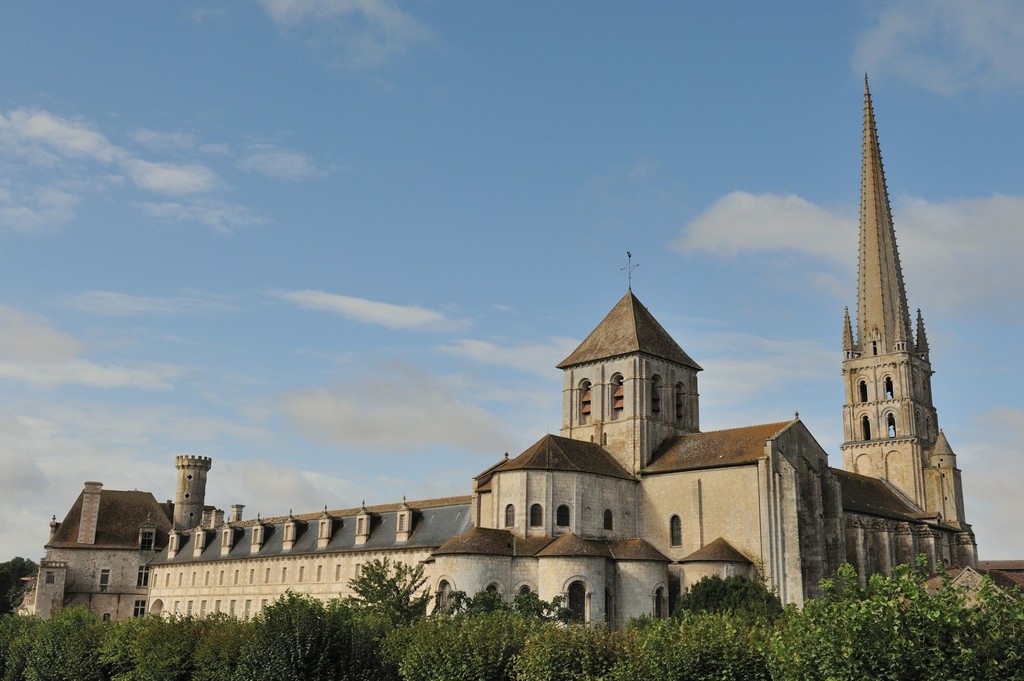
Austin In Depth
CHAPTER 3: Christian and Romanesque Themes in Kelly’s Work
Chapters
Although he enrolled himself in the tradition-bound École des Beaux-Arts on arriving in Paris, Kelly found it far more fruitful to teach himself by visiting the city’s libraries and museums and traveling to the sites and monuments that interested him. Throughout 1949, he was searching and experimenting. Using France’s art historical past as a springboard, he infused it with the sensibility of his modern vision. A perfect example of this is his ink drawing of ribbed Gothic vaulting. Through the simple act of changing its orientation, Kelly turned the vaults into a stylized floral abstraction (figure 10). A naturally gifted draftsman, the artist used this skill to explore and understand forms from a wide variety of sources. He drew from Romanesque sculpture in the Musée de Cluny (figure 11, figure 12), Chinese seals in the Musée Cernuschi, and twelfth-century manuscripts at the Byzantine Institute (figure 13, figure 14, figure 15).
That institution’s director, Thomas Whittemore, took an interest in the young artist, encouraging him to use their collections and giving him a set of photographs of the famed mosaics of Hagia Sophia in Istanbul. Their flat, iconic quality appealed to Kelly and spurred him to make a series of “Byzantine Heads” (figure 16). He followed these with paintings inspired by Christian themes, including Mother and Child and Lazarus—the former his version of the Madonna holding the Christ child, the latter of a well-known saint (figure 17, figure 18). The traditional iconography of these subjects interested Kelly less than his wish to connect with the past. Kelly focused on the figures themselves and included none of their religious attributes. On the other hand, these works have the look and feel of fresco painting on plaster, with their limited, pale palette and textured surfaces. Fresco painting is most deeply associated with celebrated religious decorative cycles in churches and chapels, so this was Kelly’s own way of engaging with a remote culture and era and giving his pieces a connection to art history.
In the spring of 1949, Kelly went on a two-week trip to study Romanesque art and architecture firsthand, following an itinerary he researched and came up with himself (figure 6). When back in Paris and painting again, he began his occasional practice of using place names as titles for his pieces. In the case of Poitiers and Tavant, the titles seem to function partly as metaphors for how visiting such places affected his work and creative process (figure 19, figure 20). The paintings depict bust-length figures influenced by Picasso, their connections to their eponymous French towns tied up with Kelly’s own subjectivity and his personal experiences of what he saw there. For example, Kelly loved the Cathedral of Notre-Dame-du-Grande in Poitiers, photographed it himself, and studied its stonework (figure 21). He was especially struck by the circular pattern on the facade, which inspired him to trace circles in the paint of Poitiers, in imitation of that surface. Similarly, in Tavant he created a work with a flat monochromatic surface and simplified forms that evoke the frescoes he admired in the church of Saint-Nicolas in that town, as well as sculptures of Romanesque heads he’d been drawing. Kelly painted Tavant during an especially fruitful sojourn to Brittany, where he spent much of the summer in Belle-Île with his friend Ralph Coburn (figure 8). This period led to important breakthroughs in his path to a mature and original style. A letter records what his makeshift studio looked like in his rented cottage, where Tavant is visible hanging on the wall with a group of more abstract drawings of seaweed (figure 22).
Two other related paintings Kelly did at Belle-Île, Monstrance and Mandorla, reflect his search for meaningful form rooted in his self-taught study of art history and his continued wish to infuse his particular modernism with the weight of the past (figure 23, figure 24). Both works used the form of a monstrance as their starting point. A monstrance is a liturgical object associated with the Catholic Mass, usually used to hold the host—the wafer that becomes the body of Christ during the sacrament of communion. These objects often took a sunburst form suggesting rays of light. Kelly painted and drew several monstrances at this time, and this interest came full circle decades later in Austin, as we can trace the lineage of its starburst window on the west facade directly back to Kelly’s early monstrance paintings and drawings.
In fact, a schematic drawing Kelly made for this window in the mid-1980s bears a strong resemblance to several of them (figure 25). Mandorla began as a monstrance, but the artist merged that rendering with the medieval stone mandorla he had admired on the facade of Notre-Dame-du-Grande. Both Monstrance and Mandorla feature motifs extracted from religious contexts that vacillate between abstraction and representation, their elemental forms maintaining something of the symbolic power they had held in an ecclesiastical context, while becoming more personal symbols for a searching young artist. Kelly’s merging of history, spiritual art, and modernist form pushed him forward to new ideas about painting and sculpture, ideas that coalesced in ever more ambitious fashion with the creation of Austin decades later.
IMAGE CREDIT: Saint-Savin-sur-Gartempe, Poitou, ca. 1060-75 (exterior perspective from northeast). Wikimedia Commons / Photo: GuyFrancis / CC3.0

